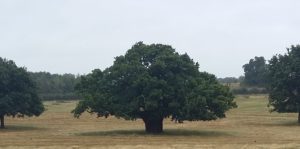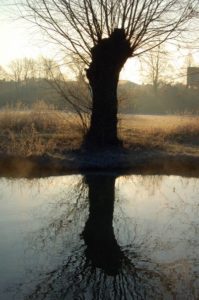Wood Pasture Ecology
Jump to: Open-grown trees |Tree ageing |Sunlight | Unimproved grassland | The matrix | Pollard trees
Open grown trees

Characteristic open-grown oak tree in Richmond Park
When grown in open situations like pastureland, trees adopt a characteristic shape. Unlike the light deprived trees of woodland that grow tall and thin with relatively little side branching, open grown trees tend to make the most of the space and light available to them by growing large side limbs. This creates the broad shaped old trees with large limbs branching from low down on the trunk. This tree form allows for large levels of deadwood to be retained within the tree, and provides a huge number of different niches. Click here to find out more about open grown trees.
Tree ageing
As trees get into their late stages of their life, their crowns retrench, which reduces the crown size, leaving stag-horn deadwood as a reminder of where the canopy used to extend. In a woodland scenario, this retrenchment would mean that the ancient tree would lose access to sunlight as it becomes out-competed by the taller trees around them. The unfortunate consequence is that this process speeds up their ageing and eventual demise. Veteran and ancient trees in wood pasture however, do not have as much competition for light, so can tolerate the natural reduction in crown size, so continue the slow ageing process for a lot longer. This means that open grown trees are able to continue their ageing process over a longer period of time, providing further important continuity for the communities living in the deadwood habitat.
Sunlight
Unlike in woods with high canopy cover, the open habit of wood pasture and parkland allows sunlight to penetrate to the trunks and the soils surrounding the trees. Sunlight penetration to the trunk is important to a number of beetles, some particularly favour the deadwood in trees that is warmed by the sun, making this feature important for the tree dwelling fauna as well as the flora.
Soils and wood warmed by sunshine can encourage the fruiting of fungi associated tree roots (mycorrhizal fungi), and those associated with the deadwood (saproxylic fungi). These fruiting bodies are important for the dispersal of these fungi as they produce the spores, and they also produce valuable micro-habitats for other invertebrates, including some rare and threatened species.
Unimproved grassland
The pasture found in wood pasture and parkland is normally undisturbed, having escaped ploughing and agricultural improvement. Fertilizers contribute to the loss of both plant and fungal diversity in grasslands. Woodland and meadow wildflowers are often adapted to nutrient poor soil in some cases this means the addition of fertilizer is directly toxic to them.
The lack of ploughing means the soil structure is left largely intact, so the complex ecosystem of the subterranean world undisturbed. The result is reduced soil erosion and less damage to fungal hyphae networks. Whilst some plants thrive in disturbed soil there are others that prefer this undisturbed soil structure.
Value of the matrix
Species do not exist in isolation and some of those living in a veteran tree will require separate habitats for different stages of their life. It is the decaying deadwood that the larvae of saproxylic insects require, but the adults often depend on other features of the wood pasture habitat. Meadow flowers in the pasture act as a nectar and pollen source for some of these in their adult form, others predate the insects that flowers or dung in the sward attract. This means that a species rich and variable sward can fulfil the other life staged of these insects, enabling then to live their full life history in wood pasture.
Pollarded trees

Willow pollard – Tom Wild
Pollarding is a tree management practice whereby a tree is heavily pruned on a rotational basis, providing a constant source of vigorous leafy growth. Historically this has been a common practice in pasture woodlands to provide both leafy foliage as a diet supplement to grazing animals and also as a source of wood. The management practice dwarfs the growth of the tree, but actually helps the trees longevity, which allows many pollarded trees to survive as veteran and even ancient trees. Although these trees do not have the canopy deadwood of a normal open grown veteran tree, it provides fantastic deadwood in the bole of the tree and in all the nooks and crevices that the management style creates. The added longevity is also a welcome feature as it increases the continuity of this habitat, one of the limiting factors in other habitats. Click here to find out more about old pollards.
